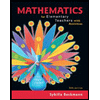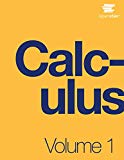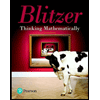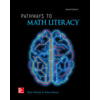
COLLEGE MATH FOR MATH2040 RMU PKG
16th Edition
ISBN: 9781323174869
Author: Barnett
Publisher: PEARSON EDUCATION (COLLEGE)
expand_more
expand_more
format_list_bulleted
Question
Chapter 6.3, Problem 14E
(A)
To determine
To form: The dual problem by using the given data.
(B)
To determine
The solution of the initial problem by using the simplex method to the dual problem and the given data.
Expert Solution & Answer
Want to see the full answer?
Check out a sample textbook solution
Students have asked these similar questions
Good Day,
Kindly assist me with the following question.
Thank you
Answer this statistic question for me
Let R be the region bounded by the following curves. Let S be the solid generated when R is revolved about the given axis. If possible, find the volume of S by both the disk/washer and shell methods. Check that your results agree
y = (x-4) - 1 x = 0, y = 63 revolved about the y-axis
Set up the integral(s) that gives the volume of the solid as a single integral if possible using the disk/washer method. Use increasing limits of integration. Select the correct choice below and fill in any answer boxes within your choice
DA SOD dy + SO
UB.
dy (Type exact answers.)
[ C) dy (Type exact answers )
Set up the integral(s) that gives the volume of the solid as a single integral if possible using the shell method. Use increasing limits of integration. Select the correct choice below and fill in any answer boxes within your choice.
OA.
dx (Type exact answers.)
OB.
dx+
SO
dx (Type exact answers.)
The volume of the solid is
(Type an exact answer.)
Chapter 6 Solutions
COLLEGE MATH FOR MATH2040 RMU PKG
Ch. 6.1 - Refer to Example 1. Find the basic solution for...Ch. 6.1 - Construct the table of basic solutions and use it...Ch. 6.1 - Prob. 3MPCh. 6.1 - Prob. 4MPCh. 6.1 - Prob. 1EDCh. 6.1 - The following linear programming problem has only...Ch. 6.1 - Prob. 1ECh. 6.1 - Prob. 2ECh. 6.1 - Prob. 3ECh. 6.1 - Prob. 4E
Ch. 6.1 - In how many ways can two variables be chosen from...Ch. 6.1 - Prob. 6ECh. 6.1 - Prob. 7ECh. 6.1 - Prob. 8ECh. 6.1 -
Problems 9–12 refer to the system
9. Find the...Ch. 6.1 - Prob. 10ECh. 6.1 - Prob. 11ECh. 6.1 - Prob. 12ECh. 6.1 - In Problems 13–20, write the e-system obtained via...Ch. 6.1 - In Problems 13–20, write the e-system obtained via...Ch. 6.1 - In Problems 13–20, write the e-system obtained via...Ch. 6.1 - Prob. 16ECh. 6.1 - Prob. 17ECh. 6.1 - Prob. 18ECh. 6.1 - Prob. 19ECh. 6.1 - Prob. 20ECh. 6.1 - Prob. 21ECh. 6.1 - Prob. 22ECh. 6.1 - Prob. 23ECh. 6.1 - Prob. 24ECh. 6.1 - Prob. 25ECh. 6.1 - Prob. 26ECh. 6.1 - Prob. 27ECh. 6.1 - Prob. 28ECh. 6.1 - Prob. 29ECh. 6.1 - Prob. 30ECh. 6.1 - Prob. 31ECh. 6.1 - Prob. 32ECh. 6.1 - Prob. 33ECh. 6.1 - Prob. 34ECh. 6.1 - Prob. 35ECh. 6.1 - Prob. 36ECh. 6.1 - Prob. 37ECh. 6.1 - Prob. 38ECh. 6.1 - Problems 31–40 refer to the partially completed...Ch. 6.1 - Prob. 40ECh. 6.1 - In Problems 41-48, convert the given i-system to...Ch. 6.1 - Prob. 42ECh. 6.1 - Prob. 43ECh. 6.1 - Prob. 44ECh. 6.1 - Prob. 45ECh. 6.1 - Prob. 46ECh. 6.1 - In Problems 41-48, convert the given i-system to...Ch. 6.1 - Prob. 48ECh. 6.1 - Prob. 49ECh. 6.1 - Prob. 50ECh. 6.1 - Prob. 51ECh. 6.1 - Prob. 52ECh. 6.1 - Prob. 53ECh. 6.1 - Prob. 54ECh. 6.1 - Prob. 55ECh. 6.1 - Prob. 56ECh. 6.1 - Prob. 57ECh. 6.1 - Prob. 58ECh. 6.1 - In Problems 59-66, solve the given linear...Ch. 6.1 - Prob. 60ECh. 6.1 - Prob. 61ECh. 6.1 - Prob. 62ECh. 6.1 - Prob. 63ECh. 6.1 - In Problems 59-66, solve the given linear...Ch. 6.1 - In Problems 59-66, solve the given linear...Ch. 6.1 - Prob. 66ECh. 6.1 - Prob. 67ECh. 6.1 - Prob. 68ECh. 6.1 - Prob. 69ECh. 6.1 - Prob. 70ECh. 6.1 - In Problems 67-70, explain why the linear...Ch. 6.1 - Prob. 72ECh. 6.1 - Prob. 73ECh. 6.1 - Prob. 74ECh. 6.1 - Prob. 75ECh. 6.1 - Prob. 76ECh. 6.2 - Solve the following linear programming problem...Ch. 6.2 - Solve using the simplex method:
Ch. 6.2 - Prob. 3MPCh. 6.2 - Prob. 1EDCh. 6.2 - Prob. 1ECh. 6.2 - Prob. 2ECh. 6.2 - Prob. 3ECh. 6.2 - Prob. 4ECh. 6.2 - Prob. 5ECh. 6.2 - Prob. 6ECh. 6.2 - Prob. 7ECh. 6.2 - Prob. 8ECh. 6.2 - In Problems 9–12,
Using slack variables, write the...Ch. 6.2 - Prob. 10ECh. 6.2 - Prob. 11ECh. 6.2 - Prob. 12ECh. 6.2 - Solve the linear programming problems in Problems...Ch. 6.2 - Prob. 14ECh. 6.2 - Solve the linear programming problems in Problems...Ch. 6.2 - Prob. 16ECh. 6.2 - Prob. 17ECh. 6.2 - Repeat Problem 17 with P = x1 + 2x2.
17.
Ch. 6.2 - Prob. 19ECh. 6.2 - Prob. 20ECh. 6.2 - Prob. 21ECh. 6.2 - Prob. 22ECh. 6.2 - Solve the linear programming problems in Problems...Ch. 6.2 - Prob. 24ECh. 6.2 - Solve the linear programming problems in Problems...Ch. 6.2 - Solve the linear programming problems in Problems...Ch. 6.2 - Solve the linear programming problems in Problems...Ch. 6.2 - Prob. 28ECh. 6.2 - Prob. 29ECh. 6.2 - Prob. 30ECh. 6.2 - Prob. 31ECh. 6.2 - Prob. 32ECh. 6.2 - Prob. 33ECh. 6.2 - Prob. 34ECh. 6.2 - Prob. 35ECh. 6.2 - Prob. 36ECh. 6.2 - Prob. 37ECh. 6.2 - Prob. 38ECh. 6.2 - In Problems 37–40, there is a tie for the choice...Ch. 6.2 - Prob. 40ECh. 6.2 - Prob. 41ECh. 6.2 - Prob. 42ECh. 6.2 - Prob. 43ECh. 6.2 - Prob. 44ECh. 6.2 - Prob. 45ECh. 6.2 - Prob. 46ECh. 6.2 - Prob. 47ECh. 6.2 - Prob. 48ECh. 6.2 - Prob. 49ECh. 6.2 - Prob. 50ECh. 6.2 - Prob. 51ECh. 6.2 - Prob. 52ECh. 6.2 - Prob. 53ECh. 6.2 - Prob. 54ECh. 6.2 - Prob. 55ECh. 6.2 - Prob. 56ECh. 6.3 - Form the dual problem:
Ch. 6.3 - Prob. 2MPCh. 6.3 - Prob. 3MPCh. 6.3 - Repeat Example 4 if the shipping charge from plant...Ch. 6.3 - Prob. 1EDCh. 6.3 - Prob. 2EDCh. 6.3 - Prob. 1ECh. 6.3 - Prob. 2ECh. 6.3 - Prob. 3ECh. 6.3 - Prob. 4ECh. 6.3 - Prob. 5ECh. 6.3 - Prob. 6ECh. 6.3 - Prob. 7ECh. 6.3 - In Problems 1–8, find the transpose of each...Ch. 6.3 - In Problems 9 and 10,
Form the dual problem.
Write...Ch. 6.3 - Prob. 10ECh. 6.3 - In Problems 11 and 12, a minimization problem, the...Ch. 6.3 - Prob. 12ECh. 6.3 - Prob. 13ECh. 6.3 - In Problems 13–20,
Form the dual problem.
Find the...Ch. 6.3 - In Problems 13–20,
Form the dual problem.
Find the...Ch. 6.3 - Prob. 16ECh. 6.3 - In Problems 13–20,
Form the dual problem.
Find the...Ch. 6.3 - Prob. 18ECh. 6.3 - Prob. 19ECh. 6.3 - Prob. 20ECh. 6.3 - Prob. 21ECh. 6.3 - Prob. 22ECh. 6.3 - Solve the linear programming problems in Problems...Ch. 6.3 - Prob. 24ECh. 6.3 - Prob. 25ECh. 6.3 - Prob. 26ECh. 6.3 - Prob. 27ECh. 6.3 - Prob. 28ECh. 6.3 - Prob. 29ECh. 6.3 - Prob. 30ECh. 6.3 - Prob. 31ECh. 6.3 - Prob. 32ECh. 6.3 - Prob. 33ECh. 6.3 - Prob. 34ECh. 6.3 - Prob. 35ECh. 6.3 - Prob. 36ECh. 6.3 - Prob. 37ECh. 6.3 - Prob. 38ECh. 6.3 - Prob. 39ECh. 6.3 - Prob. 40ECh. 6.3 - Prob. 41ECh. 6.3 - Prob. 42ECh. 6.3 - Prob. 43ECh. 6.3 - Prob. 44ECh. 6.3 - Solve the linear programming problems in Problems...Ch. 6.3 - Prob. 46ECh. 6.3 - Prob. 47ECh. 6.3 - Prob. 48ECh. 6.3 - Prob. 49ECh. 6.3 - Mining. A mining company operates two mines, each...Ch. 6.3 - Prob. 51ECh. 6.3 - Prob. 52ECh. 6.3 - Prob. 53ECh. 6.3 - Prob. 54ECh. 6.3 - Prob. 55ECh. 6.3 - Prob. 56ECh. 6.3 - Prob. 57ECh. 6.3 - Prob. 58ECh. 6.4 - Repeat Example 1 for
EXAMPLE 1
Finding the...Ch. 6.4 - Prob. 2MPCh. 6.4 - Prob. 3MPCh. 6.4 - Prob. 4MPCh. 6.4 - Prob. 5MPCh. 6.4 - Interpret the values of the slack and surplus...Ch. 6.4 - Prob. 1ECh. 6.4 - Prob. 2ECh. 6.4 - Prob. 3ECh. 6.4 - Prob. 4ECh. 6.4 - Prob. 5ECh. 6.4 - Prob. 6ECh. 6.4 - Prob. 7ECh. 6.4 - Prob. 8ECh. 6.4 - Use the big M method to solve Problems 9–22.
9.
Ch. 6.4 - Prob. 10ECh. 6.4 - Prob. 11ECh. 6.4 - Prob. 12ECh. 6.4 - Use the big M method to solve Problems 9–22.
13.
Ch. 6.4 - Prob. 14ECh. 6.4 - Use the big M method to solve Problems 9–22.
15.
Ch. 6.4 - Prob. 16ECh. 6.4 - Prob. 17ECh. 6.4 - Prob. 18ECh. 6.4 - Prob. 19ECh. 6.4 - Prob. 20ECh. 6.4 - Use the big M method to solve Problems 9-22.
21....Ch. 6.4 - Prob. 22ECh. 6.4 - Prob. 23ECh. 6.4 - Prob. 24ECh. 6.4 - Problems 25–32 are mixed. Some can be solved by...Ch. 6.4 - Prob. 26ECh. 6.4 - Prob. 27ECh. 6.4 - Prob. 28ECh. 6.4 - Prob. 29ECh. 6.4 - Prob. 30ECh. 6.4 - Prob. 31ECh. 6.4 - Prob. 32ECh. 6.4 - In Problems 33–38, construct a mathematical model...Ch. 6.4 - In Problems 33–38, construct a mathematical model...Ch. 6.4 - In Problems 33-38, construct a mathematical model...Ch. 6.4 - Prob. 36ECh. 6.4 - Prob. 37ECh. 6.4 - Prob. 38ECh. 6.4 - Prob. 39ECh. 6.4 - Prob. 40ECh. 6.4 - Prob. 41ECh. 6.4 - Prob. 42ECh. 6.4 - Prob. 43ECh. 6.4 - Prob. 44ECh. 6.4 - Prob. 45ECh. 6.4 - Prob. 46ECh. 6.4 - Prob. 47ECh. 6 - Prob. 1RECh. 6 - Prob. 2RECh. 6 - Prob. 3RECh. 6 - Prob. 4RECh. 6 - Prob. 5RECh. 6 - Prob. 6RECh. 6 - Prob. 7RECh. 6 - Prob. 8RECh. 6 - Prob. 9RECh. 6 - Prob. 10RECh. 6 - Prob. 11RECh. 6 - Prob. 12RECh. 6 - Prob. 13RECh. 6 - Prob. 14RECh. 6 - Prob. 15RECh. 6 - Prob. 16RECh. 6 - Prob. 17RECh. 6 - Prob. 18RECh. 6 - Prob. 19RECh. 6 - Prob. 20RECh. 6 - Prob. 21RECh. 6 - Prob. 22RECh. 6 - Prob. 23RECh. 6 - Prob. 24RECh. 6 - Prob. 25RECh. 6 - Prob. 26RECh. 6 - Prob. 27RECh. 6 - Prob. 28RECh. 6 - In Problems 28 and 29,
Introduce slack, surplus,...Ch. 6 - Prob. 30RECh. 6 - Prob. 31RECh. 6 - Prob. 32RECh. 6 - Prob. 33RECh. 6 - Prob. 34RECh. 6 - Prob. 35RECh. 6 - Prob. 36RECh. 6 - Prob. 37RECh. 6 - Prob. 38RECh. 6 - Prob. 39RECh. 6 - Prob. 40RECh. 6 - Prob. 41RE
Knowledge Booster
Learn more about
Need a deep-dive on the concept behind this application? Look no further. Learn more about this topic, subject and related others by exploring similar questions and additional content below.Similar questions
- An airline owns an aging fleet of Boeing 737 jet airplanes. It is considering a major purchase of up to 17 new Boeing model 787 and 767 jets. The decision must take into account numerous cost and capability factors, including the following: (1) the airline can finance up to $1.6 billion in purchases; (2) each Boeing 787 will cost $80 million, and each Boeing 767 will cost $110 million; (3) at least one-third of the planes purchased should be the longer-range 787; (4) the annual maintenance budget is to be no more than $8 million; (5) the annual maintenance cost per 787 is estimated to be $800,000, and it is $500,000 for each 767; and (6) each 787 can carry 125,000 passengers per year, whereas each 767 can fly 81,000 passengers annually. Formulate this as an integer programming problem to maximize the annual passenger-carrying capability. What category of integer programming problem is this? Solve this problemarrow_forwardA drag racer accelerates at a(t) = 96 ft/s². Assume that v(0) = 0 and s(0) = 0. a. Determine the position function for t≥ 0. b. How far does the racer travel in the first 6 s? c. At this rate, how long will it take the racer to travel 1 mi? 3 d. How long will it take the racer to travel 300 ft? e. How far has the racer traveled when it reaches a speed of 175 ft/s? a. The position function for t20 is s(t) = b. In the first 6 s, the racer travels ft. (Simplify your answer. Type an integer or decimal rounded to three decimal places as needed.) 1 c. At this rate, it will take the racer s to travel mi 3 (Do not round until the final answer. Then round to three decimal places as needed.) d. It will take the racer s to travel 300 ft. (Do not round until the final answer. Then round to three decimal places as needed.) ft. e. When the racer reaches a speed of 175 ft/s, it has traveled (Do not round until the final answer. Then round to three decimal places as needed.)arrow_forwardGood Day, Please assist with this practice question. Thanksarrow_forward
- Find the volume of the solid that is generated when the given region is revolved as described. The region bounded by f(x) = 8x In x and the x-axis on [1,2] is revolved about the x-axis. The volume is (Type an exact answer.)arrow_forwardConsider an object moving along a line with the given velocity v. Assume t is time measured in seconds and velocities have units of a. Determine when the motion is in the positive direction and when it is in the negative direction. b. Find the displacement over the given interval. c. Find the distance traveled over the given interval. v(t) = 31² - 36t+105; [0,8] a. When is the motion in the positive direction? Select the correct choice and, if necessary, fill in the answer box to complete your choice. OA. The motion is in the positive direction for t-values in the interval(s) (Use a comma to separate answers as needed. Type your answers in interval notation.) OB. The motion is never in the positive direction. When is the motion in the negative direction? Select the correct choice and, if necessary, fill in the answer box to complete your choice. OA. The motion is in the negative direction for t-values in the interval(s) (Use a comma to separate answers as needed. Type your answers in…arrow_forwardEvaluate the following integral. √ In ² (x²), In √ Im ²(x²) dx = X dx ☐ dx = (Type an integer or a simplified fraction.)arrow_forward
- A spring on a horizontal surface can be stretched and held 0.5 m from its equilibrium position with a force of 35 N. a. How much work is done in stretching the spring 1.5 m from its equilibrium position? b. How much work is done in compressing the spring 0.5 m from its equilibrium position? a. Set up the integral that gives the work done in stretching the spring 1.5 m from its equilibrium position. Use increasing limits of integration. 10 dx (Type exact answers. The amount of work done is (Simplify your answer.) b. Set up the integral that gives the work done in compressing the spring 0.5 m from its equilibrium position. Use decreasing limits of integration. dx (Type exact answers.) The amount of work done is (Simplify your answer.)arrow_forwardFind the volume of the solid generated when the region bounded by y = 5x and y = 15√x is revolved about the x-axis. The volume of the solid is cubic units. (Type an exact answer.)arrow_forwardEvaluate the following integral using integration by parts. √xsi x sin 4x dx √x sin 4x dx = ☐arrow_forward
- Find the arc length of the following curve on the given interval. 2 X y= Inx- on [4,20] 8 The arc length of y = Inx- 8 on [4,20] is ☐ (Type an exact answer.)arrow_forward2 X Let = dx Complete parts (a) through (c) below. x-1 a. Evaluate I using the substitution u-x-1 X OXF (Use parentheses to clearly denote the argument of each function.) b. Evaluate after first performing long division on the integrand Simplify the integrand by dividing. Write it as a sum of terms where the numerators of all fractions have lower degree than the denominators. X-1 (Use integers or fractions for any numbers in the expression.) Evaluate the integral dx = (Use parentheses to clearly denote the argument of each function.) c. Reconcile the results in parts (a) and (b). Choose the correct answer below. OA. When the antiderivative in part (a) is expanded, the expression is the same as that obtained in part (b), except that the antiderivative in part (a) has a leading term of degree 3, while the antiderivative in part (b) has only terms of degree 2 or less. OB. The antiderivative obtained using one of the methods includes a term involving the natural logarithm function, while…arrow_forwardK 2 In the graph to the right, the equation of the parabola is x = (y-3)² 3 and the equation of the line is y = 9-x. Determine the area of the shaded region in the figure. The area of the shaded region is (Type an exact answer.) SAMSUNGarrow_forward
arrow_back_ios
SEE MORE QUESTIONS
arrow_forward_ios
Recommended textbooks for you
 Discrete Mathematics and Its Applications ( 8th I...MathISBN:9781259676512Author:Kenneth H RosenPublisher:McGraw-Hill Education
Discrete Mathematics and Its Applications ( 8th I...MathISBN:9781259676512Author:Kenneth H RosenPublisher:McGraw-Hill Education Mathematics for Elementary Teachers with Activiti...MathISBN:9780134392790Author:Beckmann, SybillaPublisher:PEARSON
Mathematics for Elementary Teachers with Activiti...MathISBN:9780134392790Author:Beckmann, SybillaPublisher:PEARSON
 Thinking Mathematically (7th Edition)MathISBN:9780134683713Author:Robert F. BlitzerPublisher:PEARSON
Thinking Mathematically (7th Edition)MathISBN:9780134683713Author:Robert F. BlitzerPublisher:PEARSON Discrete Mathematics With ApplicationsMathISBN:9781337694193Author:EPP, Susanna S.Publisher:Cengage Learning,
Discrete Mathematics With ApplicationsMathISBN:9781337694193Author:EPP, Susanna S.Publisher:Cengage Learning, Pathways To Math Literacy (looseleaf)MathISBN:9781259985607Author:David Sobecki Professor, Brian A. MercerPublisher:McGraw-Hill Education
Pathways To Math Literacy (looseleaf)MathISBN:9781259985607Author:David Sobecki Professor, Brian A. MercerPublisher:McGraw-Hill Education

Discrete Mathematics and Its Applications ( 8th I...
Math
ISBN:9781259676512
Author:Kenneth H Rosen
Publisher:McGraw-Hill Education

Mathematics for Elementary Teachers with Activiti...
Math
ISBN:9780134392790
Author:Beckmann, Sybilla
Publisher:PEARSON


Thinking Mathematically (7th Edition)
Math
ISBN:9780134683713
Author:Robert F. Blitzer
Publisher:PEARSON

Discrete Mathematics With Applications
Math
ISBN:9781337694193
Author:EPP, Susanna S.
Publisher:Cengage Learning,

Pathways To Math Literacy (looseleaf)
Math
ISBN:9781259985607
Author:David Sobecki Professor, Brian A. Mercer
Publisher:McGraw-Hill Education
Solve ANY Optimization Problem in 5 Steps w/ Examples. What are they and How do you solve them?; Author: Ace Tutors;https://www.youtube.com/watch?v=BfOSKc_sncg;License: Standard YouTube License, CC-BY
Types of solution in LPP|Basic|Multiple solution|Unbounded|Infeasible|GTU|Special case of LP problem; Author: Mechanical Engineering Management;https://www.youtube.com/watch?v=F-D2WICq8Sk;License: Standard YouTube License, CC-BY
Optimization Problems in Calculus; Author: Professor Dave Explains;https://www.youtube.com/watch?v=q1U6AmIa_uQ;License: Standard YouTube License, CC-BY
Introduction to Optimization; Author: Math with Dr. Claire;https://www.youtube.com/watch?v=YLzgYm2tN8E;License: Standard YouTube License, CC-BY